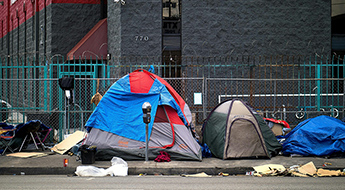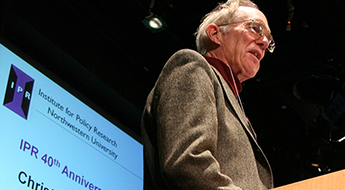"Black Picket Fences" Revisited
Second edition of book continues to further research on the black middle class
Get all our news
Black Picket Fences was published in the last century,” Pattillo explained at a recent IPR colloquium. “That might sound overly dramatic, but considering the changes that have taken place since 1999, it’s not totally hyperbole.”

Mary Pattillo talks with IPR economist Jonathan Guryan after a lecture
discussing the second edition of her book.
While the Great Recession has taken its toll on everyone, it has hit middle-class blacks hardest, with the unemployment rate for blacks hitting 16 percent as compared with just 8 percent for whites, a gap that has remained steady for decades.
Recently, sociologist and IPR associate Mary Pattillo released the second edition of her ground-breaking book Black Picket Fences: Privilege and Peril Among the Black Middle Class—one of only a few ethnographic studies of a black middle-class neighborhood. In the 2013 edition, she revisited the same topics discussed in the 1999 original—namely the economy, crime, and housing—and put them in context with the economic downturn and the foreclosure crisis.
“Black Picket Fences was published in the last century,” Pattillo explained at a recent IPR colloquium. “That might sound overly dramatic, but considering the changes that have taken place since 1999, it’s not totally hyperbole.”
The result of Pattillo living for three years in "Groveland," a pseudonymous black middle-class neighborhood on Chicago's South Side, the first edition explored both the advantages enjoyed by black middle class families as well as the challenges they still faced. She updated the second edition with new interview data, offering descriptive demographics to re-examine the trajectories of Groveland’s residents and the neighborhood as a whole.
As Pattillo points out, African Americans are more likely to hold public-sector jobs and use public-sector services. Thus, public-sector cuts during economic downturns are more debilitating to black communities. Plus, black homeowners bore the brunt of the subprime mortgage bubble and foreclosure crisis.

But when Pattillo interviewed residents about the foreclosure crisis, they did not share stories of friends or family members who had lost their homes. Instead, they talked about the aftermath—all of the boarded up, vacant houses that now lined the streets. Many Groveland residents worried that the foreclosed houses would eventually be bought by investors who would turn them into rental properties, mainly targeted at families using housing vouchers. Some long-term residents felt that increasing the numbers of low-income families moving in would destabilize their neighborhood.
Even though crime rates have remained fairly steady, the number of foreclosures and the subsequent increase in renters without longstanding ties to the neighborhood caused uneasiness among many of those Pattillo interviewed. The uneasiness extended even to those who had grown up in the neighborhood and had long lived near areas with criminal and gang-related activities. But now that they are parents, Pattillo discovered, they hesitate to take their own children to the same parks where they had played, preferring safer suburban parks instead.
“What is happening in Groveland,” said Pattillo, “is that the complex story about federal and local housing policies and widespread racial discrimination in the mortgage market is reduced to a more simple and visible target—former public housing families and low-income voucher holders.”
With this second edition, Pattillo furthers her thought-provoking work on the black middle class. It continues to be relevant, she points out, as middle-class blacks still live in neighborhoods that are much more disadvantaged than their white counterparts, even as they move to the suburbs in large numbers.
Mary Pattillo is Harold Washington Professor of Sociology and African American Studies and an IPR associate.
Published: October 21, 2013.


